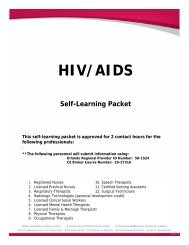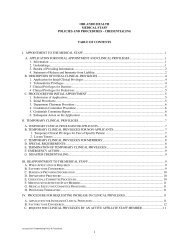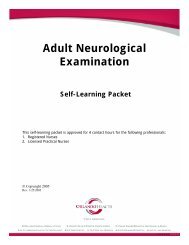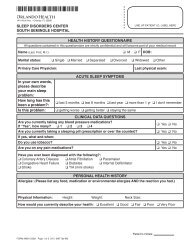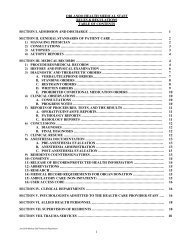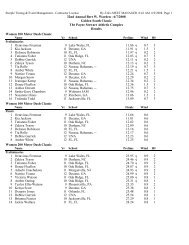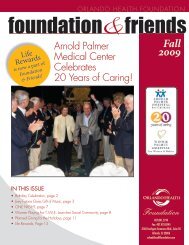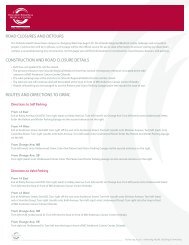Introduction to CV Pharmacology - Orlando Health
Introduction to CV Pharmacology - Orlando Health
Introduction to CV Pharmacology - Orlando Health
You also want an ePaper? Increase the reach of your titles
YUMPU automatically turns print PDFs into web optimized ePapers that Google loves.
<strong>CV</strong> <strong>Pharmacology</strong><br />
The American College of Cardiology/American Heart Association Guidelines for the<br />
Management of Patients with ST-Elevation MI guidelines list the absolute and relative<br />
contraindications of fibrinolytic therapy. These are viewed as advisory for clinical decision<br />
making and may not be all-inclusive.<br />
NOTE: See package insert or institutional guidelines for more information, as well as the<br />
ACC/AHA Guidelines for the Management of Patients with ST Elevation Myocardial Infarction<br />
(updated 7/1/04) via the ACC website as listed in the References section of this SLP.<br />
Absolute contraindications <strong>to</strong> the use of fibrinolytics include:<br />
<br />
<br />
<br />
<br />
<br />
<br />
<br />
<br />
ANY HISTORY OF INTRACRANIAL HEMORRHAGE<br />
Known malignant intracranial neoplasm (primary or metastatic)<br />
Known structural cerebral vascular lesion (e.g., AVM)<br />
Ischemic stroke within 3 months EXCEPT acute ischemic stroke within 3 hours<br />
Active internal bleeding or bleeding diathesis (excluding menses)<br />
Suspected aortic dissection<br />
Acute pericarditis<br />
Significant closed head or facial trauma within 3 months<br />
Relative contraindications must be weighed against potential benefits and include:<br />
Severe uncontrolled hypertension (>180/110) or his<strong>to</strong>ry of chronic severe<br />
hypertension<br />
His<strong>to</strong>ry of prior ischemic stroke greater than 3 months, dementia, or known<br />
intracranial pathology not covered in contraindications<br />
Pregnancy<br />
Active peptic ulcer or recent internal bleeding within the previous 2-4 weeks<br />
Non-compressible vascular punctures<br />
Current use of anticoagulants, the higher the INR, the higher the risk of bleeding<br />
Traumatic or prolonged (greater than 10 minutes) CPR or major surgery with<br />
the previous 3 weeks<br />
For strep<strong>to</strong>kinase/anistreplase: Prior exposure ( more than 5 days) or prior<br />
allergic reaction <strong>to</strong> these agents<br />
All patients are <strong>to</strong> be moni<strong>to</strong>red closely for signs of bleeding, including changes in neurological<br />
status, abdominal pain or rigidity, or hypotension. When used in the management of acute<br />
myocardial infarction, the patient may experience chest pain or dysrhythmias when the coronary<br />
artery opens and the supply of oxygenated blood <strong>to</strong> the myocardium is res<strong>to</strong>red (reperfusion). It<br />
is vital not <strong>to</strong> s<strong>to</strong>p the administration of the fibrinolytic agent due <strong>to</strong> reperfusion symp<strong>to</strong>ms. If<br />
needed, symp<strong>to</strong>ms are <strong>to</strong> be managed with morphine and antidysrhythmics.<br />
2010 <strong>Orlando</strong> <strong>Health</strong>, Education & Development 45



